PM2.5 particles: what is it, where is it from and why is everyone talking about it
Welcome everyone to Tion's blog! We continue to talk about "threats from the air." This time it will be about PM2.5 fine particles. Today everyone talks about them: environmentalists, doctors, the media. Why not talk to us too.
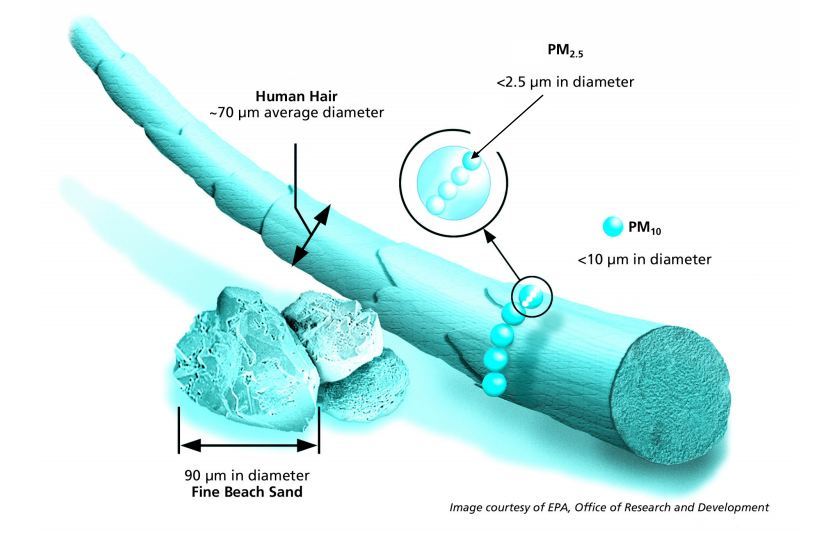
In our very first article on Geektimes, we wrote about the HEPA filter, which cleans the air from these PM2.5. And now, finally, we will tell you what these particles are, where they come from and why they harm not only the respiratory system, but also the circulatory system. Ready for a long reading?
')
This is an air pollutant, which consists of both solid microparticles and the smallest droplets of liquids. And those and others in size from about 10 nm to 2.5 microns. Other designations and names of PM2.5 particles: FSP (fine suspended particles), fine particles, fine particles, fine suspended particles, fine dust.
Quite small particles (of the order of 1 nm and less) are already gas molecules. For example, the diameter of a molecule of water and oxygen is 0.30 nm, nitrogen - 0.32 nm, hydrogen - 0.25 nm. In such small bodies, the behavior is very different from PM2.5 particles. About the gases, we will tell another time, below we talk about solid microparticles.
All these particles and droplets smaller than 2.5 microns in size are suspended in air. They are in the forest and the sea, but it is in the city that pose the greatest danger. First, they are usually much larger in the city, and secondly, the chemical composition of the fine aerosol in the city is more dangerous than in nature. By the way, the composition of the PM2.5 aerosol and the parameters of individual particles can vary greatly in different cities.
What are PM2.5 solids? It depends on where they come from. By origin PM2.5 are divided into:
According to the type of source, PM2.5 particles are divided into:
The mass concentration of PM2.5 is a key parameter for assessing air quality and its threat to human health. According to the norms of the World Health Organization (WHO), the average annual level of PM2.5 should not exceed 10 µg / m3, and the average daily level should not exceed 25 µg / m3.
The actual concentration of particles in the air is estimated by various environmental monitoring services around the world. The largest online air monitoring - The World Air Quality Index . It shows the air quality index in cities around the world. This index is considered for all air pollutants. And the main one is precisely PM2.5.
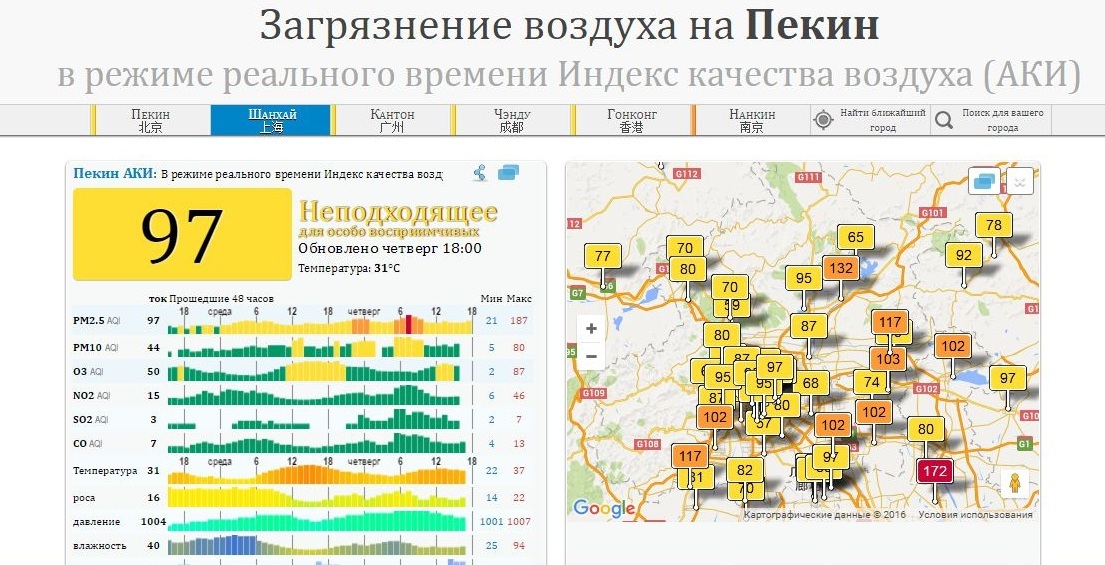
Service, by the way, is very good. Although the translation into Russian leaves much to be desired :)
How many PM2.5 in Russia? Million question. And the answer to it, in fact, no. Because in Russia there is actually no data on the quality of street air. This is very easy to show using the same The World Air Quality Index. See how much data is in Europe:
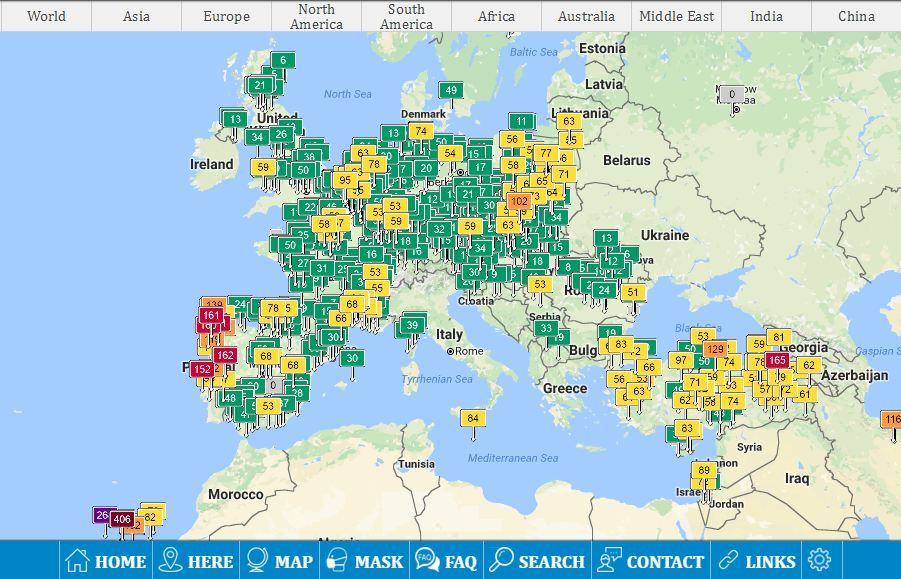
In China:
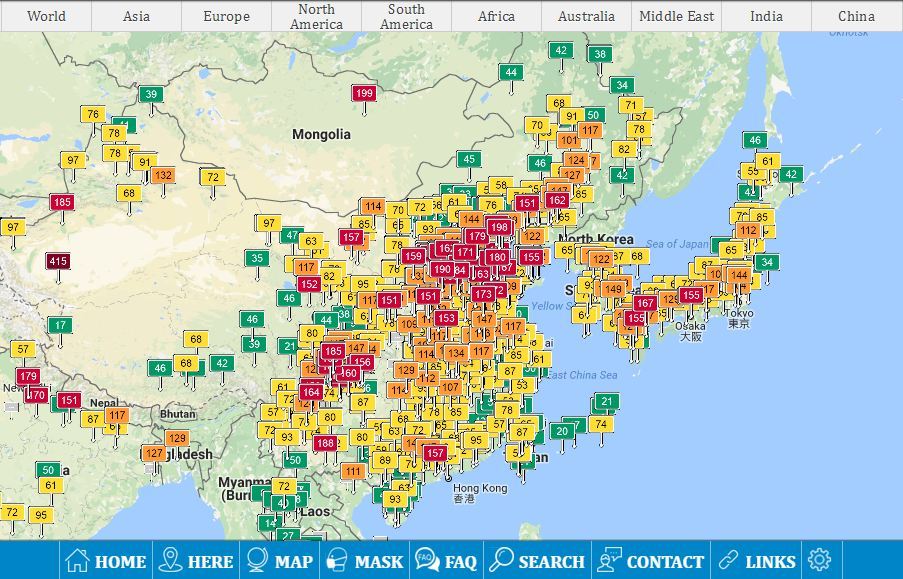
And in Russia:
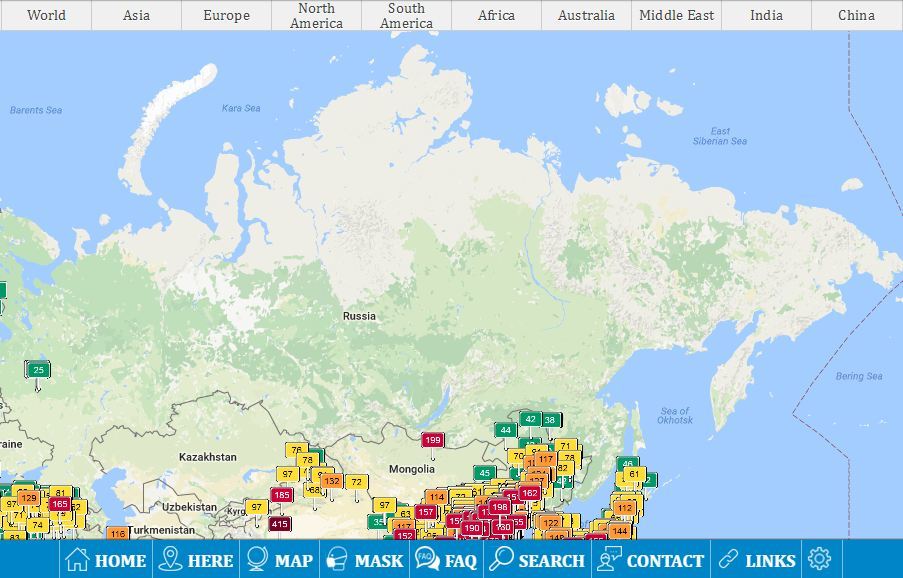
In addition to a dozen stations in Moscow (which is not enough to cover a large city), consider information on Russia that it does not. Therefore, we are now working on our own monitoring of CityAir.ru street air. This is a large-scale project, details about it will definitely be there, but later.
In modern China, almost every inhabitant of a megapolis knows this abbreviation.
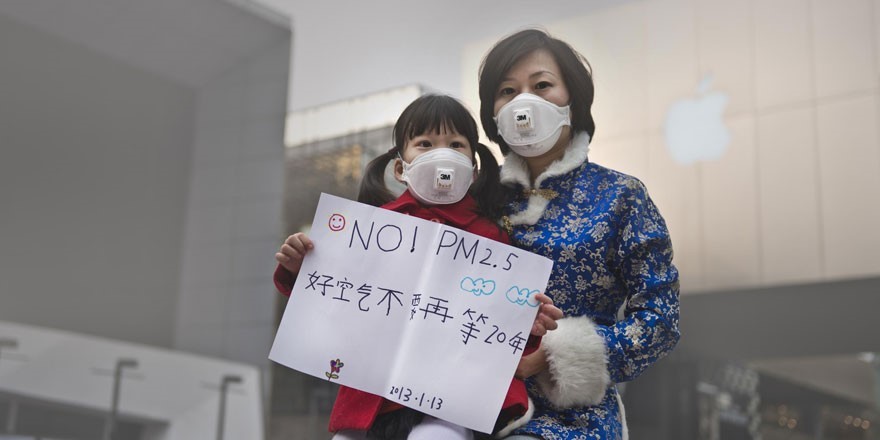
In the rest of the world, these particles are also "gaining popularity." This is due to an elementary fact: PM2.5 particles are dangerous. And the danger is becoming more and more obvious. From 1990 to 2010, 3.1 million people died from the causes of PM2.5 particles. Another figure: PM2.5 particles reduce life expectancy by an average of 8.6 months. A total of 3% of deaths from diseases of the cardiovascular and respiratory systems and 5% of deaths from lung cancer are associated with PM2.5. The source is the latest major World Health Organization report on air pollution and its effects on human health. [one]
(Links to this and other sources at the end of the article).
Everyone is accustomed to fear harmful gases: inhale them - and immediately get poisoned. Perhaps these are echoes of the war years and fears of chemical warfare agents, man-made disasters and gloomy pictures of people in gas masks. But in fact, the particles are no less dangerous. People breathe them every day. For small doses of PM2.5, there is no instantaneous reaction, as to a poison gas, but they accumulate in the body and can lead to serious problems over time.
In the urban air, in principle, many different particles: small and large, light and heavy. Only heavy particles eventually "fall" on the ground (remember the black snow next to some plant), and light PM2.5 practically does not settle. Small particles more difficult to overcome the resistance of the environment and "fall" on the ground. And for the smallest particles, resistance is rendered also by the Brownian motion.
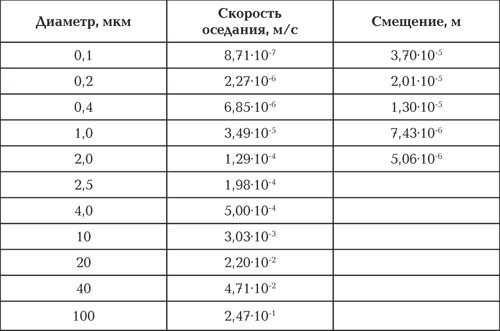
As can be seen from the table, for PM2.5 particles, the sedimentation rate is 15 times lower than for PM10, and is about 0.2 mm / s. This value is compensated by even a slight upward air flow. And for the so-called ultra-fine particles of PM0.1 (with a diameter of up to 0.1 μm), the Brownian motion completely dominates over the sedimentation rate. Therefore, this smallest fraction of particles may never settle.
Of course, part of PM2.5 is precipitated, including with rains, but there are so many sources of these particles in the city that they constantly accumulate in the atmosphere. If you turn off the wind, the bricks will start falling from the city air.
It is possible to catch the PM2.5 using the very HEPA filters . Therefore, there is no less talk of HEPA filters lately than about PM2.5 itself. We will not repeat and again talk about filtering. It is better to explain what these particles do with our body.
The main source of information on the effects of PM2.5 on the body is a report on the relationship between air pollution and cardiovascular diseases [2].
PM2.5 particles are also called respirable, inhaled fraction. They are so small that they pass through the biological barriers in our body: the nasal cavity, upper respiratory tract, bronchi. PM2.5, along with air, goes directly to the alveoli - the bubbles in which gas exchange takes place between the lungs and blood vessels.
In the early 2000s, a scientist by the name of Peters (Peters) showed that the effect of the smallest particles causes two responses in the human body:
Trying to find an explanation for this, Peters put forward two main hypotheses about how PM2.5 and in general any air pollutants affect the cardiovascular and respiratory systems.
Hypothesis number 1: about the "quick" answer
The bottom line: the smallest particles irritate certain receptors in the airways and trigger a reflex that changes the heart rate and respiration rate. The nervous system works, and nervous regulation always has a quick response to an irritant.
Hypothesis number 2: about the "slow" answer
Essence: the smallest particles are deposited in the lungs, blood vessels and cause inflammation in them. In response to inflammation, the number of special signaling proteins, cytokines, increases in the blood. They start a chain of biochemical reactions that ultimately lead to thrombosis, and then to coronary heart disease, heart attack, etc. This response of the body takes more time than the nervous reaction.
To back up these hypotheses with facts, the researchers followed PM2.5 in the body and identified six main mechanisms of the harmful effects of particles:
The nerve fibers in the brain receives signals from receptors that are located in the walls of the respiratory tract: in the nose, mouth, throat, larynx, trachea, bronchi and in the lungs themselves. These receptors react to various stimuli: temperature, mechanical action, stretching of the walls of the bronchi, etc. And as it turned out, the PM2.5 particles, too.
A particle has hit the receptor - a person can cough up, there may be tickling and burning in the chest. At the same time, the bronchi are narrowed, sighs become shorter, breathing becomes more frequent and shallow. So the body is trying less to inhale this filth and get rid of those particles that have managed to get inside. But such obvious reactions as coughing may not be, and the reflex response will be triggered.
In addition to respiratory failure, cardiac arrhythmia may occur. It is unclear how exactly PM2.5 affects the cardiovascular system, but there is a statistically significant connection between them, this is a fact. Example study on this topic: the work of 1999 Wichmann (Wichmann) with a sample of 4,000 people. It shows that patients with arrhythmia become 50% more each time after an increase in PM2.5 concentration in urban air.
PM2.5 affects not only the receptors in the walls of the respiratory tract, but also the lung epithelium cells themselves. And this effect is especially dangerous in the area of the alveoli - pulmonary vesicles, entangled in a network of capillaries.
The diameter of these capillaries is very small, less than 5 microns. Red blood cells are literally screwed into them. At the moment of contact of the erythrocyte with the capillary wall, a single three-layer membrane is obtained: the erythrocyte wall, the capillary wall and the wall of the pulmonary alveoli. Such close contact between blood cells and the respiratory tract facilitates gas exchange: hemoglobin in the erythrocyte binds oxygen, and the cytoplasm releases carbon dioxide dissolved with the participation of carbonic anhydrase.

The endotheliocyte is a cell of the capillary wall. Surfactant - "pulmonary lubricant" to facilitate gas exchange.
This alveolar capillary membrane is the first barrier to dirty air. In vitro studies [3] showed that PM2.5 particles destroy this barrier. They slow down the growth and reproduction of lung epithelial cells and even kill them. If this happens in vitro, it can occur in the body.
What is dangerous violation of the alveolar-capillary membrane? The fact that the main function of the lungs is disturbed is gas exchange. This can lead to hypoxia (little oxygen) and hypercapnia (a lot of carbon dioxide). We wrote about hypoxia and hypercapnia recently .
A few words about infectious inflammation. When microbes enter the body, immune cells secrete special proteins - cytokines. Cytokines distribute a signal of danger throughout the body. In the bone marrow begin to produce special cells of the immune system - macrophages. This is a detachment of "siloviks" who can absorb and "digest" microbes. The battlefield of macrophages and microbes is the focus of inflammation.

Inflammation develops with a viral or bacterial infection. Reasonable question: on PM2.5, immunity may not react? But he reacts. A study in rabbits shows a link between PM2.5 and inflammation in the lungs. In rabbits that breathed air with a high content of PM2.5, increased bone marrow activity was noted. And the higher the activity, the more macrophages in the lungs.
Inflammation of the lungs in rabbits is one example. As you already know, the smallest PM2.5 can penetrate into the blood, and with it into any part of the body. Therefore, they can cause inflammation not only in the lungs, but also in the walls of blood vessels, and in other organs.
Having collected such data, a group of researchers led by Seaton and Dennekamp (Seaton, Dennekamp) suggested that the body’s immune response to PM2.5 is the same as the response to pathogens. And not only that any inflammation in itself can lead to the hospital, it also triggers two other dangerous processes.
The first of these processes is the acceleration of blood clotting. Blood coagulates under the influence of many biochemical factors. Speaking of PM2.5, fibrinogen and CRP protein (C-related protein) should be distinguished from these factors. The mechanism by which PM2.5 start blood clotting with fibrinogen and CRP is well known.
In short, the mechanism is as follows. First, macrophages capture particles. At the same time, they produce various substances, including special cytokines that stimulate the bone marrow and liver. The bone marrow begins to actively produce white blood cells and platelets (cells involved in blood coagulation). And the liver starts to release fibrinogen and CRP protein faster. As a result, the blood thickens and increases the risk of thrombosis.
The second process following inflammation is the so-called destabilization of fatty (lipid) deposits on the walls of blood vessels. It's about the very atherosclerotic plaques, which are often talked about on TV. Almost every adult has these plaques in various quantities. They are located on the inner wall of the vessel and are protected by a special fibrous thickening, the so-called tire.
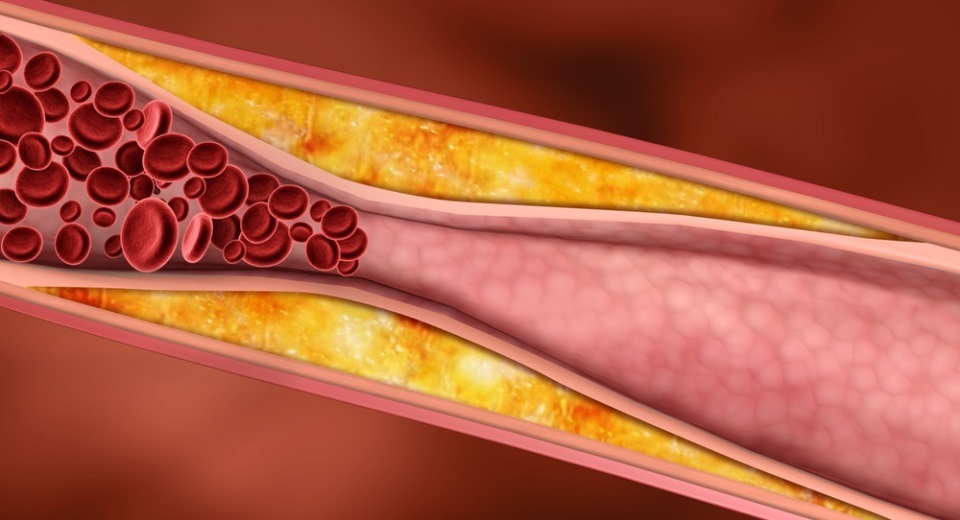
Macrophages capture PM2.5 particles and secrete cytokine proteins — in response, MCP protein is released from the vessel walls. He, as a traffic controller, directs fresh macrophages and T-lymphocytes to the inflammatory focus. And if the focus is in fat deposits, then macrophages and T-lymphocytes “in a frenzy” can attack not only PM2.5, but also the cells of the organism itself. As a result, in this place the cells in the vessel wall die, the fibrous thickening weakens, and the contents of the plaque can jump out into the vessel lumen.
Increased blood clotting and pieces of lipid deposits, walking through the vessels - two factors that significantly increase the risk of thrombosis.
And in order to completely finish off the cardiovascular system, PM2.5 particles also constrict blood vessels. A study with a huge sample (5362 people from 45 to 84 years old) [4] showed a statistically significant relationship between PM2.5 poisoning and arterial wall thickening.
The specific mechanism of the process is not described in the article. Perhaps this is another manifestation of inflammatory processes. Anyway, the thickening of the walls is another factor affecting the lumen of the vessels and the development of atherosclerosis.
Imagine a situation where a person breathes air with a critically high concentration of particles (for example, as in Beijing during a strong smog). Moreover, it breathes all day, without any respirators and not hiding in the apartment with breather. How will his body react?
At first, PM2.5 irritates receptors in the airways, and the nervous system sends a signal to the lungs to work more often. The bronchial lumen narrows, the person begins to breathe often and shallowly, superficially. The load on the heart increases: arrhythmia, tachycardia. This all happens within the first 2 hours after inhalation; this is the so-called “quick” response to PM2.5.
During the day, the body may develop inflammation with a cascade of biochemical and physiological reactions. Increased cytokines, blood clots, atherosclerotic plaque detachment, vascular thickening, thrombosis. This is a “slow” answer.
The result of such a scenario: an increase in the risk of cardiovascular diseases (coronary heart disease, myocardial infarction, stroke).
In fact, the situation described above is extremely rare. Few people will sit 24 hours on the street when a red level of danger is declared in the city because of smog. It is difficult to imagine that a healthy person in one day will get coronary heart disease due to dirty air. Our generalization is rather a scarecrow about the ecological situation. But at the heart of this pugalki is modern reality, therefore, it cannot be ignored.
In a large city, there are always PM2.5 particles in the air. It is a fact. And we inhale them anyway. This is also a fact. The question is, what is the average daily dose of PM2.5 the body receives. If the air outside is dirty, but at home we are protected by breathers or purifiers, then we reduce the number of particles inhaled per day, give the body a break. If he manages to clear out debris and recover, the likelihood of the above health problems will be significantly less.
Another thing is if day by day more harmful particles get into us than it manages to get out. Then they will accumulate in the body. The symptoms of “poisoning” of PM2.5 will manifest imperceptibly: out of breath a few steps earlier than usual, sometimes aching in the chest, heart pounding more often and so on. The body slowly wears out of dirty air, but there is no sharp deterioration in health. The negative effect is not instantaneous, but delayed. But this is no less serious.
On a day, the average city dweller inhales 200 billion PM2.5 particles. Half of them are deposited in the lungs. One such dose will be without serious consequences. But over time, PM2.5 deposits in the body will overtake at a critical level, and then everything can become much worse.
What to do? The answer is simple: defend against PM2.5.
In Beijing, it makes sense to defend yourself on the street (with respirator masks) and at home ( fresh air with a HEPA filter ). In Moscow, it makes no sense to bother with masks - there is not such a concentration of PM2.5 in the street air. But about the ventilation should attend. Most of the time we spend indoors. And if all this time to breathe air with a background level of PM2.5, a decent average daily dose of particles will be accumulated. If you breathe clean air even at home, the body will have time to cleanse from what has fallen on the street.
That's all. Thank you for your attention and be healthy!
Sources:

In our very first article on Geektimes, we wrote about the HEPA filter, which cleans the air from these PM2.5. And now, finally, we will tell you what these particles are, where they come from and why they harm not only the respiratory system, but also the circulatory system. Ready for a long reading?
')
What is PM2.5 and where are they from
This is an air pollutant, which consists of both solid microparticles and the smallest droplets of liquids. And those and others in size from about 10 nm to 2.5 microns. Other designations and names of PM2.5 particles: FSP (fine suspended particles), fine particles, fine particles, fine suspended particles, fine dust.
Quite small particles (of the order of 1 nm and less) are already gas molecules. For example, the diameter of a molecule of water and oxygen is 0.30 nm, nitrogen - 0.32 nm, hydrogen - 0.25 nm. In such small bodies, the behavior is very different from PM2.5 particles. About the gases, we will tell another time, below we talk about solid microparticles.
Why exactly 2.5 microns? Looking ahead, let's say: unlike the larger particles, PM2.5 easily penetrate biological barriers and therefore pose the greatest threat to the body.
All these particles and droplets smaller than 2.5 microns in size are suspended in air. They are in the forest and the sea, but it is in the city that pose the greatest danger. First, they are usually much larger in the city, and secondly, the chemical composition of the fine aerosol in the city is more dangerous than in nature. By the way, the composition of the PM2.5 aerosol and the parameters of individual particles can vary greatly in different cities.
What are PM2.5 solids? It depends on where they come from. By origin PM2.5 are divided into:
- Primary PM2.5
Thrown into the air ready. The smallest pieces of soot, asphalt and automobile tires, particles of mineral salts (sulfates, nitrates), heavy metal compounds (mainly oxides). Biological pollutants (some allergens and microorganisms) also apply to PM2.5.
A few words about soot particles. Coal is a good sorbent, so toxic compounds are deposited on even the smallest particles of soot. When operating internal combustion engines it is, for example, high molecular weight polycyclic aromatic hydrocarbons. It turns out not just a particle of soot, but a particle “with a filling” of harmful organic matter. - Secondary PM2.5
Formed directly in the atmosphere. One example: oxides of nitrogen and sulfur are emitted into the city air, they form acids upon contact with water, and solid particles of salts (nitrates and sulfates) are obtained from them.
According to the type of source, PM2.5 particles are divided into:
- Artificial (man-made)
The main anthropogenic source of particles is transport. Internal combustion engines and industrial processes with the combustion of solid fuels (coal, lignite, oil), construction, mining, many types of production (especially the production of cement, ceramics, bricks, smelting), in cities can be a source of erosion of road surface and erase brake pads and tires. Even agriculture is a source of ammonia from which secondary PM2.5 can be formed. - Natural (non-anthropogenic)
Sources: soil erosion in arid areas and organic evaporation.
How much PM2.5 is in the air
The mass concentration of PM2.5 is a key parameter for assessing air quality and its threat to human health. According to the norms of the World Health Organization (WHO), the average annual level of PM2.5 should not exceed 10 µg / m3, and the average daily level should not exceed 25 µg / m3.
The actual concentration of particles in the air is estimated by various environmental monitoring services around the world. The largest online air monitoring - The World Air Quality Index . It shows the air quality index in cities around the world. This index is considered for all air pollutants. And the main one is precisely PM2.5.
Service, by the way, is very good. Although the translation into Russian leaves much to be desired :)
How many PM2.5 in Russia? Million question. And the answer to it, in fact, no. Because in Russia there is actually no data on the quality of street air. This is very easy to show using the same The World Air Quality Index. See how much data is in Europe:
In China:
And in Russia:
In addition to a dozen stations in Moscow (which is not enough to cover a large city), consider information on Russia that it does not. Therefore, we are now working on our own monitoring of CityAir.ru street air. This is a large-scale project, details about it will definitely be there, but later.
Why did everyone suddenly talk about PM2.5
In modern China, almost every inhabitant of a megapolis knows this abbreviation.

In the rest of the world, these particles are also "gaining popularity." This is due to an elementary fact: PM2.5 particles are dangerous. And the danger is becoming more and more obvious. From 1990 to 2010, 3.1 million people died from the causes of PM2.5 particles. Another figure: PM2.5 particles reduce life expectancy by an average of 8.6 months. A total of 3% of deaths from diseases of the cardiovascular and respiratory systems and 5% of deaths from lung cancer are associated with PM2.5. The source is the latest major World Health Organization report on air pollution and its effects on human health. [one]
(Links to this and other sources at the end of the article).
Everyone is accustomed to fear harmful gases: inhale them - and immediately get poisoned. Perhaps these are echoes of the war years and fears of chemical warfare agents, man-made disasters and gloomy pictures of people in gas masks. But in fact, the particles are no less dangerous. People breathe them every day. For small doses of PM2.5, there is no instantaneous reaction, as to a poison gas, but they accumulate in the body and can lead to serious problems over time.
That is why the WHO report is not talking about peak jumps of PM2.5 during industrial emissions, but about the chronic effects of these particles on the body. The volume of exposure, under which every day there are residents of large cities.
Why do airborne PM2.5 accumulate in the air?
In the urban air, in principle, many different particles: small and large, light and heavy. Only heavy particles eventually "fall" on the ground (remember the black snow next to some plant), and light PM2.5 practically does not settle. Small particles more difficult to overcome the resistance of the environment and "fall" on the ground. And for the smallest particles, resistance is rendered also by the Brownian motion.

As can be seen from the table, for PM2.5 particles, the sedimentation rate is 15 times lower than for PM10, and is about 0.2 mm / s. This value is compensated by even a slight upward air flow. And for the so-called ultra-fine particles of PM0.1 (with a diameter of up to 0.1 μm), the Brownian motion completely dominates over the sedimentation rate. Therefore, this smallest fraction of particles may never settle.
Of course, part of PM2.5 is precipitated, including with rains, but there are so many sources of these particles in the city that they constantly accumulate in the atmosphere. If you turn off the wind, the bricks will start falling from the city air.
It is possible to catch the PM2.5 using the very HEPA filters . Therefore, there is no less talk of HEPA filters lately than about PM2.5 itself. We will not repeat and again talk about filtering. It is better to explain what these particles do with our body.
The influence of PM2.5: two hypotheses and six mechanisms
The main source of information on the effects of PM2.5 on the body is a report on the relationship between air pollution and cardiovascular diseases [2].
PM2.5 particles are also called respirable, inhaled fraction. They are so small that they pass through the biological barriers in our body: the nasal cavity, upper respiratory tract, bronchi. PM2.5, along with air, goes directly to the alveoli - the bubbles in which gas exchange takes place between the lungs and blood vessels.
The smallest PM2.5 particles can be released into the blood during gas exchange. Therefore, diseases of not only the respiratory system, but also the cardiovascular are associated with them. Moreover, they pollute the particles themselves, and harmful compounds sorbed on the smallest particles of coal soot.
In the early 2000s, a scientist by the name of Peters (Peters) showed that the effect of the smallest particles causes two responses in the human body:
- Conditionally "fast": after 2 hours
- Conditionally "slow": after 24 hours
Trying to find an explanation for this, Peters put forward two main hypotheses about how PM2.5 and in general any air pollutants affect the cardiovascular and respiratory systems.
Hypothesis number 1: about the "quick" answer
The bottom line: the smallest particles irritate certain receptors in the airways and trigger a reflex that changes the heart rate and respiration rate. The nervous system works, and nervous regulation always has a quick response to an irritant.
Hypothesis number 2: about the "slow" answer
Essence: the smallest particles are deposited in the lungs, blood vessels and cause inflammation in them. In response to inflammation, the number of special signaling proteins, cytokines, increases in the blood. They start a chain of biochemical reactions that ultimately lead to thrombosis, and then to coronary heart disease, heart attack, etc. This response of the body takes more time than the nervous reaction.
To back up these hypotheses with facts, the researchers followed PM2.5 in the body and identified six main mechanisms of the harmful effects of particles:
- Pulmonary receptor stimulation: increased respiration, cardiac arrhythmia
- Destruction of lung epithelial cells
- Development of inflammatory response
- Increased blood clotting
- Destabilization of atherosclerotic plaques
- Thickening of the vessel walls
1. Excitation of pulmonary receptors: increased respiration, cardiac arrhythmia
The nerve fibers in the brain receives signals from receptors that are located in the walls of the respiratory tract: in the nose, mouth, throat, larynx, trachea, bronchi and in the lungs themselves. These receptors react to various stimuli: temperature, mechanical action, stretching of the walls of the bronchi, etc. And as it turned out, the PM2.5 particles, too.
A particle has hit the receptor - a person can cough up, there may be tickling and burning in the chest. At the same time, the bronchi are narrowed, sighs become shorter, breathing becomes more frequent and shallow. So the body is trying less to inhale this filth and get rid of those particles that have managed to get inside. But such obvious reactions as coughing may not be, and the reflex response will be triggered.
In addition to respiratory failure, cardiac arrhythmia may occur. It is unclear how exactly PM2.5 affects the cardiovascular system, but there is a statistically significant connection between them, this is a fact. Example study on this topic: the work of 1999 Wichmann (Wichmann) with a sample of 4,000 people. It shows that patients with arrhythmia become 50% more each time after an increase in PM2.5 concentration in urban air.
2. Disruption of pulmonary epithelial cells
PM2.5 affects not only the receptors in the walls of the respiratory tract, but also the lung epithelium cells themselves. And this effect is especially dangerous in the area of the alveoli - pulmonary vesicles, entangled in a network of capillaries.
The diameter of these capillaries is very small, less than 5 microns. Red blood cells are literally screwed into them. At the moment of contact of the erythrocyte with the capillary wall, a single three-layer membrane is obtained: the erythrocyte wall, the capillary wall and the wall of the pulmonary alveoli. Such close contact between blood cells and the respiratory tract facilitates gas exchange: hemoglobin in the erythrocyte binds oxygen, and the cytoplasm releases carbon dioxide dissolved with the participation of carbonic anhydrase.

The endotheliocyte is a cell of the capillary wall. Surfactant - "pulmonary lubricant" to facilitate gas exchange.
This alveolar capillary membrane is the first barrier to dirty air. In vitro studies [3] showed that PM2.5 particles destroy this barrier. They slow down the growth and reproduction of lung epithelial cells and even kill them. If this happens in vitro, it can occur in the body.
What is dangerous violation of the alveolar-capillary membrane? The fact that the main function of the lungs is disturbed is gas exchange. This can lead to hypoxia (little oxygen) and hypercapnia (a lot of carbon dioxide). We wrote about hypoxia and hypercapnia recently .
3. The development of an inflammatory response
A few words about infectious inflammation. When microbes enter the body, immune cells secrete special proteins - cytokines. Cytokines distribute a signal of danger throughout the body. In the bone marrow begin to produce special cells of the immune system - macrophages. This is a detachment of "siloviks" who can absorb and "digest" microbes. The battlefield of macrophages and microbes is the focus of inflammation.

Inflammation develops with a viral or bacterial infection. Reasonable question: on PM2.5, immunity may not react? But he reacts. A study in rabbits shows a link between PM2.5 and inflammation in the lungs. In rabbits that breathed air with a high content of PM2.5, increased bone marrow activity was noted. And the higher the activity, the more macrophages in the lungs.
Inflammation of the lungs in rabbits is one example. As you already know, the smallest PM2.5 can penetrate into the blood, and with it into any part of the body. Therefore, they can cause inflammation not only in the lungs, but also in the walls of blood vessels, and in other organs.
Having collected such data, a group of researchers led by Seaton and Dennekamp (Seaton, Dennekamp) suggested that the body’s immune response to PM2.5 is the same as the response to pathogens. And not only that any inflammation in itself can lead to the hospital, it also triggers two other dangerous processes.
4. Increased blood clotting
The first of these processes is the acceleration of blood clotting. Blood coagulates under the influence of many biochemical factors. Speaking of PM2.5, fibrinogen and CRP protein (C-related protein) should be distinguished from these factors. The mechanism by which PM2.5 start blood clotting with fibrinogen and CRP is well known.
In short, the mechanism is as follows. First, macrophages capture particles. At the same time, they produce various substances, including special cytokines that stimulate the bone marrow and liver. The bone marrow begins to actively produce white blood cells and platelets (cells involved in blood coagulation). And the liver starts to release fibrinogen and CRP protein faster. As a result, the blood thickens and increases the risk of thrombosis.
5. Destabilization of atherosclerotic plaques
The second process following inflammation is the so-called destabilization of fatty (lipid) deposits on the walls of blood vessels. It's about the very atherosclerotic plaques, which are often talked about on TV. Almost every adult has these plaques in various quantities. They are located on the inner wall of the vessel and are protected by a special fibrous thickening, the so-called tire.

Macrophages capture PM2.5 particles and secrete cytokine proteins — in response, MCP protein is released from the vessel walls. He, as a traffic controller, directs fresh macrophages and T-lymphocytes to the inflammatory focus. And if the focus is in fat deposits, then macrophages and T-lymphocytes “in a frenzy” can attack not only PM2.5, but also the cells of the organism itself. As a result, in this place the cells in the vessel wall die, the fibrous thickening weakens, and the contents of the plaque can jump out into the vessel lumen.
Increased blood clotting and pieces of lipid deposits, walking through the vessels - two factors that significantly increase the risk of thrombosis.
6. Thickening of the vessel walls
And in order to completely finish off the cardiovascular system, PM2.5 particles also constrict blood vessels. A study with a huge sample (5362 people from 45 to 84 years old) [4] showed a statistically significant relationship between PM2.5 poisoning and arterial wall thickening.
The specific mechanism of the process is not described in the article. Perhaps this is another manifestation of inflammatory processes. Anyway, the thickening of the walls is another factor affecting the lumen of the vessels and the development of atherosclerosis.
Summary: What does PM2.5 do in the body?
Imagine a situation where a person breathes air with a critically high concentration of particles (for example, as in Beijing during a strong smog). Moreover, it breathes all day, without any respirators and not hiding in the apartment with breather. How will his body react?
At first, PM2.5 irritates receptors in the airways, and the nervous system sends a signal to the lungs to work more often. The bronchial lumen narrows, the person begins to breathe often and shallowly, superficially. The load on the heart increases: arrhythmia, tachycardia. This all happens within the first 2 hours after inhalation; this is the so-called “quick” response to PM2.5.
During the day, the body may develop inflammation with a cascade of biochemical and physiological reactions. Increased cytokines, blood clots, atherosclerotic plaque detachment, vascular thickening, thrombosis. This is a “slow” answer.
The result of such a scenario: an increase in the risk of cardiovascular diseases (coronary heart disease, myocardial infarction, stroke).
Conclusion
In fact, the situation described above is extremely rare. Few people will sit 24 hours on the street when a red level of danger is declared in the city because of smog. It is difficult to imagine that a healthy person in one day will get coronary heart disease due to dirty air. Our generalization is rather a scarecrow about the ecological situation. But at the heart of this pugalki is modern reality, therefore, it cannot be ignored.
In a large city, there are always PM2.5 particles in the air. It is a fact. And we inhale them anyway. This is also a fact. The question is, what is the average daily dose of PM2.5 the body receives. If the air outside is dirty, but at home we are protected by breathers or purifiers, then we reduce the number of particles inhaled per day, give the body a break. If he manages to clear out debris and recover, the likelihood of the above health problems will be significantly less.
Another thing is if day by day more harmful particles get into us than it manages to get out. Then they will accumulate in the body. The symptoms of “poisoning” of PM2.5 will manifest imperceptibly: out of breath a few steps earlier than usual, sometimes aching in the chest, heart pounding more often and so on. The body slowly wears out of dirty air, but there is no sharp deterioration in health. The negative effect is not instantaneous, but delayed. But this is no less serious.
The main danger of PM2.5 lies not in the sharp jumps in concentration, but in the chronic effect of these particles on the body.
On a day, the average city dweller inhales 200 billion PM2.5 particles. Half of them are deposited in the lungs. One such dose will be without serious consequences. But over time, PM2.5 deposits in the body will overtake at a critical level, and then everything can become much worse.
What to do? The answer is simple: defend against PM2.5.
In Beijing, it makes sense to defend yourself on the street (with respirator masks) and at home ( fresh air with a HEPA filter ). In Moscow, it makes no sense to bother with masks - there is not such a concentration of PM2.5 in the street air. But about the ventilation should attend. Most of the time we spend indoors. And if all this time to breathe air with a background level of PM2.5, a decent average daily dose of particles will be accumulated. If you breathe clean air even at home, the body will have time to cleanse from what has fallen on the street.
That's all. Thank you for your attention and be healthy!
Sources:
- Health effects of particulate matter
- Cardiovascular Disease and Air Pollution
- Cell cycle alterations induced by urban PM2.5 in bronchial cells: characterization of the process and possible mechanisms involved
- Cartid Intima-Medial Thickness

Source: https://habr.com/ru/post/396111/
All Articles